Feeling stuck in a hobby rut? You’re not alone. Many find traditional hobbies like knitting or painting a tad too common. Did you know Classpop offers classes in everything from cooking to art, making it easy to dive into something new? Our guide will walk you through niche hobbies that pack a punch – think beekeeping and puppetry, offering more than just fun.
Ready for an adventure?
Key Takeaways
Niche hobbies like beekeeping, puppetry, and orchid cultivation offer unique challenges that can lead to personal fulfillment, stress relief, and opportunities for social interaction.
Getting started in these hobbies often doesn’t require a lot of money but does need creativity, patience, and a willingness to learn from others already skilled in the area.
Many niche hobbies have communities both online and offline where hobbyists can share tips, collaborate on projects, or even turn their passion into a small business.
Activities such as terrarium building and amateur radio operation allow people to express themselves creatively while also providing educational value through hands-on experience with nature or technology.
Engaging in less common pastimes not only brings new experiences into one’s life but also helps build confidence through mastering new skills.
Table of Contents
The Joy and Benefits of Niche Hobbies
Diving into niche hobbies offers more than just a way to kill time. These activities fill your free hours with excitement and learning opportunities. Think of beekeeping or puppetry—they’re not your everyday pastimes.
They offer unique challenges and let you tap into communities where everyone shares your interests. Plus, mastering these skills can lead to personal fulfillment and relaxation.
Imagine turning your hobby into something bigger, like collaborations within the industry. This could be creating content for social media, joining forces with other hobbyists for projects, or even starting a small business related to your passion.
The possibilities are endless, and who knows? You might just find yourself at the forefront of an emerging trend.
Next up, let’s explore the enchanting world of orchid cultivation.
Orchid Cultivation
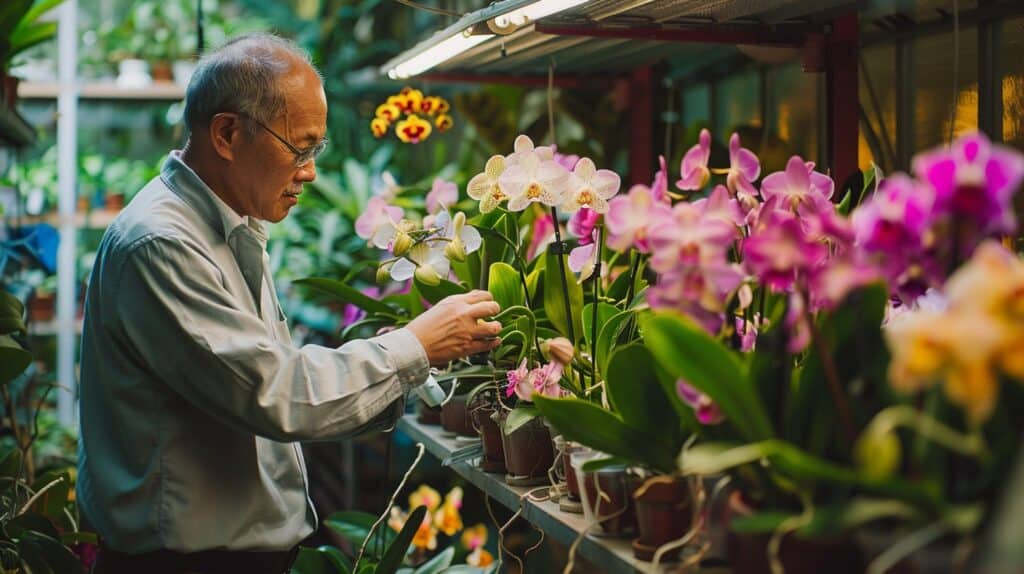
Digging into orchid growing, it’s like opening a door to a secret garden. You’ll get your hands dirty, sure, but you’ll find out why these vibrant flowers are more than just eye candy.
The Basics of Orchid Cultivation
Orchid cultivation is like unlocking a secret garden where creativity and personal growth flourish. It’s not just about growing flowers; it’s about nurturing your mind and soul.
Here’s how to get started with orchid cultivation:
- Choose the right type of orchid. There are many kinds, but some are easier for beginners. Look for Phalaenopsis or “moth orchids.” They’re tough and can bloom more than once a year.
- Get the soil mix right. Orchids don’t use regular dirt. They prefer a mix of bark, sphagnum moss, and perlite. This mixture keeps their roots healthy by draining water well.
- Pick a spot with indirect light. Orchids love light, but not direct sunlight. A windowsill that gets morning sun is perfect.
- Water wisely. Unlike other plants, orchids need less water. Wait until their soil mix is almost dry before watering again.
- Feed them right. Use a fertilizer made for orchids every month except when they are flowering.
- Keep an eye on humidity and temperature—orchids thrive in warm, humid environments similar to their natural tropical habitat.
- Repot when necessary, usually every couple of years or when the potting mix breaks down.
By following these steps, you open up to a world where patience pays off in beautiful blooms that can brighten both your home and spirit.
Next up: Why orchid cultivation stands out as a hobby…
Why Orchid Cultivation is a Unique Hobby
Growing orchids goes beyond just planting flowers; it’s like becoming a part of an exclusive club. This hobby opens doors to mental health perks and stress relief that you won’t find in your everyday garden.
Imagine turning a stressful day into one filled with tranquility, just by spending some time with your orchid buddies. Plus, it’s not every day you get bragging rights about your exotic bloom collection among friends or on social media.
This hobby isn’t only about creating a personal oasis; it offers chances for expressing yourself creatively and relaxation not found in other pastimes. Blogging about your journey from sprout to full bloom can connect you with fellow enthusiasts, opening up opportunities to swap stories or even tips on the best way to care for these captivating plants.
And let’s not forget – those blog posts might just turn into a little side hustle, selling ad space or offering guidance to newbies wanting to dive into the world of exotic floriculture themselves.
Rapid Language Learning

Rapid Language Learning is like unlocking a new superpower. I love picking up random languages, like Polish. For instance, “legalne kasyno” means “legal casino” in Polish – handy since I enjoy online gambling.
It’s amazing how quickly you can start understanding others with just a few tips and tricks!
The Basics of Rapid Language Learning
Rapid language learning might sound like a tough nut to crack, but it’s totally doable with the right approach. It’s all about smart strategies and real talk. Here’s how you can get started:
- Dive into the deep end – Immersion is key. Listen to music, watch movies, and follow YouTube channels in your target language. Your brain will start picking up patterns without you even trying.
- Get chatty – Find conversation partners online or join local language meetups. Speaking regularly builds confidence and helps you learn from mistakes.
- Flashcards are your friends – Use apps to drill vocabulary and phrases on the go. A few minutes each day adds up fast.
- Keep a diary – Try writing daily in the language you’re learning, even just a few sentences about your day or thoughts.
- Grammar? Yes, but not too much – Understand the basics, then focus on communication rather than perfection.
- Set bite – sized goals – Aim for small wins, like ordering food in a new language or writing a short email.
- Celebrate mistakes – They’re just stepping stones to getting better. Laugh it off and keep going.
- Mix it up – Combine reading, writing, speaking, and listening activities to engage different parts of your brain.
- Be consistent – Practice a little every day rather than cramming once in a while.
- Take an online course– Plenty out there can guide you step by step at your own pace.
- Go abroad if you can– Nothing beats being in a place where the language surrounds you all day, every day.
- Use tech wisely– Language learning apps and software make practicing fun and engaging.
By breaking down rapid language learning into manageable chunks like this, you’ll see progress sooner than you think…and hey, who doesn’t want to brag about being bilingual (or even trilingual)? Let’s get those brain gears grinding!
Why Rapid Language Learning is a Unique Hobby
So, you’ve got the basics down. now let’s dive into why picking up new languages at lightning speed is more than just a party trick. For starters, it opens doors both personally and professionally that few other hobbies can.
Imagine chatting fluently with locals during your travels, or adding “multilingual” to your resume. It’s not just about memorizing words; it’s about connecting with cultures on a deeper level.
Plus, this isn’t a solo journey — online communities and language apps bring learners together from all corners of the globe. You could be cracking jokes in Spanish one minute and solving puzzles in Japanese the next, all from your living room.
And here’s an extra kicker: once you get good, sharing your journey through blogging can even turn into a nice little side hustle. So yeah, rapid language learning? It’s definitely in its own league.
Astrophotography

Astrophotography takes you on a cosmic road trip without leaving your backyard. It’s like fishing in the sky, but instead of fish, you catch stars with your camera.
Basics of Astrophotography
Astrophotography lets you capture the night sky in all its glory. It’s like fishing for stars, but instead of a rod, you have a camera. Let’s dive into what makes this hobby shine.
- Start with the right gear. You’ll need a digital single – lens reflex (DSLR) camera or a mirrorless camera. Both can work magic under the stars.
- Invest in a sturdy tripod. The Earth won’t stop moving for your photo, so stability is key to clear shots.
- A telescope isn’t just for stargazing anymore. Attach it to your camera to zoom in on distant galaxies and nebulas.
- Learn the art of long exposure. This technique captures more light, making dim stars visible in your photos.
- Use a remote shutter release or your camera’s timer function. Even pressing the shutter button can shake the camera and blur your cosmic masterpiece.
- Understand how to manually set your camera’s ISO, aperture, and shutter speed for optimal results; trial and error lead to perfection here.
- Scouting for location matters more than one might think; light pollution from cities drowns out starlight, so head out where skies are dark and clear.
- Editing software like Adobe Photoshop can enhance the details and colors in your astrophotos… bringing out the beauty hidden in raw images.
- Patience is not just a virtue; it’s a necessity. Some nights might be too cloudy or moonlit for ideal conditions – wait for that perfect clear sky night!
- Time spent learning about celestial events and constellations adds an extra layer of enjoyment when you finally capture them with your lens.
With these points in mind, you’re well on your way to capturing breathtaking snapshots of our universe – turning dark skies into canvas for awe-inspiring photographs… Next up: mastering calisthenics to balance physical prowess with stellar photography skills!
What Makes Astrophotography Stand Out
Capturing the night sky brings a whole new level of cool to photography. Imagine setting up your camera and telescope to snap shots beyond our world—stars, constellations, and maybe even galaxies far away.
It’s like fishing in the vast ocean of space, where you’re always surprised by what you catch. This hobby lets you grow creatively as you figure out how to best capture these celestial wonders.
Astrophotography isn’t just about taking pretty pictures. It opens doors to making some cash from your passion or sharing your cosmic captures on social media platforms. Picture being part of a growing community that gets why zooming into the night sky is thrilling.
Whether for fun or profit, turning your gaze upwards could be the start of an exciting adventure far beyond ordinary hobbies.
Calisthenics

Calisthenics turns the world into your gym, using bodyweight for push-ups and pull-ups. It’s like dancing with gravity – simple moves that build strength without fancy equipment.
The Fundamentals of Calisthenics
Calisthenics is all about making the most of what you’ve got. Using your body weight and gravity, it offers a solid alternative to yoga and Pilates. Now, let’s break down how to get started and what makes this workout tick.
- Start with the basics: push-ups, pull-ups, squats, lunges, and planks are your new best friends. These exercises lay the groundwork for everything in calisthenics.
- Focus on form over speed: Doing an exercise correctly is more important than doing it quickly. Take your time to learn each movement.
- Build a routine: Consistency is key in calisthenics. Aim to work out at least three times a week.
- Mix things up: Once you’ve mastered the basics, add variety to keep challenging your muscles. Try different variations of the standard exercises.
- Use parks and playgrounds: No gym? No problem! Outdoor areas provide excellent spaces for calisthenics workouts.
- Progress at your own pace: Listen to your body and only move on to more advanced moves when you’re ready.
- Find a community: Whether it’s online or in-person, connecting with others can provide motivation and support.
- Set goals: Having targets helps keep you focused and gives you something to strive towards.
- Keep learning: There’s always something new to discover in calisthenics, from techniques to training methods.
With just these steps, men of any age can dive into calisthenics and enjoy the benefits of improved strength, flexibility, and overall health—no fancy equipment required!
Why Calisthenics is a Unique Hobby
Think of Calisthenics as your gym, where the world’s your playground. No need for heavy, costly equipment or a fancy membership. Just you, gravity, and sheer determination sculpting your body.
It meshes strength, flexibility, and endurance into one seamless routine. Imagine turning a park bench into your workout station—now that’s inventive!
This hobby doesn’t just build muscle; it hones creativity in movement and exercise. You’re not following someone else’s steps—you’re crafting your own dance with push-ups, pull-ups, and planks.
Every motion is an expression of personal strength and artistic flair… a physical poem if you will. It’s more than fitness; it’s art in action—an engaging blend appealing to movers eager to shape their physique outside the confines of walls and weights.
Terrarium Building
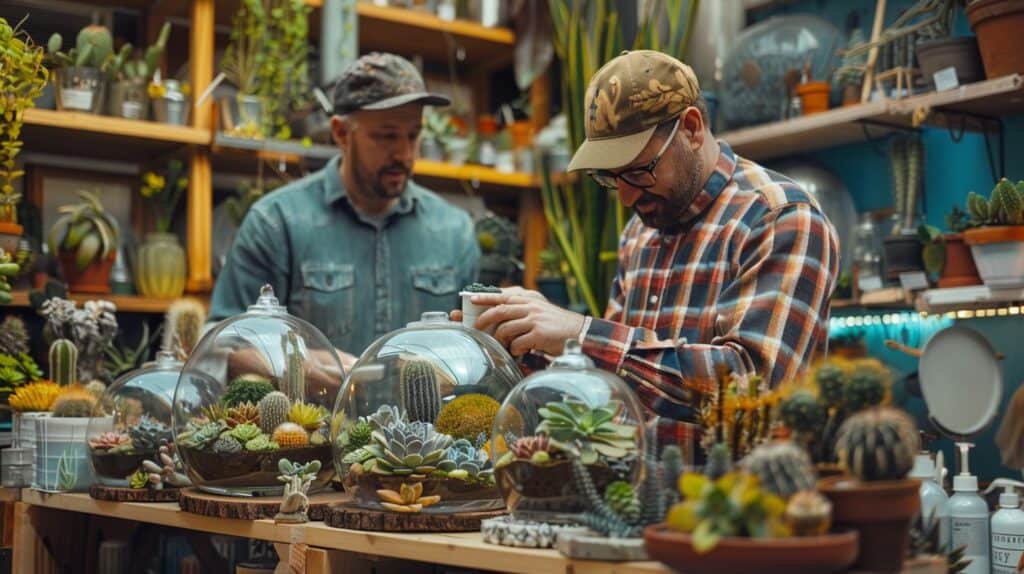
Ever tried your hand at making a mini world in a glass? Terrarium building lets you do just that, playing mother nature to plants and stones inside a clear container.
The Basics of Terrarium Building
Terrarium building lets you bring a piece of nature indoors. It’s like creating your own mini-world where you call the shots.
- Choose your container wisely – Glass jars, bowls, or even a brandy snifter work great. Just make sure it’s clear glass so you can enjoy your mini-garden.
- Pick the right plants – Go for small plants that enjoy humidity. Ferns, mosses, and air plants are perfect partners in crime.
- Layer up – Start with stones or pebbles at the bottom for drainage. Next comes activated charcoal to keep things fresh, followed by soil specifically made for terrariums.
- Placement matters – Keep your terrarium in a spot that gets plenty of light, but not direct sunlight. Think of it as a sunbathing spot, but without the risk of sunburn.
- Water cautiously – These little worlds don’t need much water. A spray here and there keeps them happy without flooding their tiny space.
- Get creative with decorations – This is where you can really shine. Add some rocks, wood pieces, or tiny figures to make your terrarium uniquely yours.
Building terrariums isn’t just about making something pretty; it’s an adventure in creativity and patience… And hey, talking about adventures in tiny green worlds might just make you the most interesting person at any party! Plus, there’s always room to grow—both your skills and your collection of miniature landscapes.
Why Terrarium Building is a Unique Hobby
Now that you’ve got a handle on the basics, let’s dive deeper. Terrarium building isn’t just any ordinary hobby. It’s like being captain of your own tiny nature sanctuary. You get to call the shots in crafting a miniature world where plants thrive under your care—a real boost for anyone looking to unwind and express themselves creatively.
It’s all about bringing nature indoors, in a glass container no less! Picture having a small jungle or desert right on your desk. This hobby offers relaxation and strengthens your mental fitness without needing to step outside.
Plus, each terrarium is a personal art project; it’s an opportunity to mold an ecosystem that reflects who you are. How many hobbies let you play god and designer with living things? Not many, I’d wager.
So go ahead, shape those little worlds—your mind (and office) will thank you for it.
Amateur Radio Operation

Amateur Radio Operation is like sending your voice on an epic journey without leaving your couch. It’s all about radio waves, antennas, and making friends in far-off places.
The Basics of Amateur Radio Operation
Diving into amateur radio operation is like unlocking a door to a global conversation. It’s not just about chatting; it’s a mix of tech skills, emergency preparedness, and community.
Here’s how you get started:
- Get informed about ham radios. These aren’t your average walkie-talkies. They can reach across continents.
- Understand the rules. Yes, there are rules in this game. The FCC (Federal Communications Commission) lays them out for every radio enthusiast.
- Study for the exam. To legally transmit, you’ll need a license from the FCC. Hit the books; it’s worth it.
- Choose your gear wisely. Start with something simple – maybe a handheld transceiver. You don’t need to break the bank.
- Join a club. There’s no better way to learn than from those already in the game. Plus, ham radio folks love to help newbies.
- Practice makes perfect…or at least better! Start by listening to others on the airwaves.
- Tinker with electronics repair and building projects as skills grow.
- Help in emergencies by providing critical communication when other systems fail.
This hobby isn’t just for passing time; it creates lifesavers and connects people worldwide through old-school waves and signals–truly amazing if you ask me!
Why Amateur Radio Operation is a Unique Hobby
Amateur radio operation is more than just a hobby; it’s a doorway to the globe. You get to chat with people from all over, without needing the internet. Imagine sitting in your living room but being able to connect with someone halfway around the world.
It’s like having friends everywhere, accessible through your radio. This hobby goes beyond simple conversations; it builds bridges, forges friendships and creates a global community right at your fingertips.
You also become a bit of a technician along the way. Buying and restoring old broken radios not only saves you money but hones skills that could come in handy during emergencies. Think about it – being able to fix things when no one else can? That’s both cool and useful.
Plus, sharing what you learn about gear or giving tips through content creation keeps this hobby fresh and engaging for everyone involved.
Next up: exploring why Puppetry captivates so many.
Puppetry
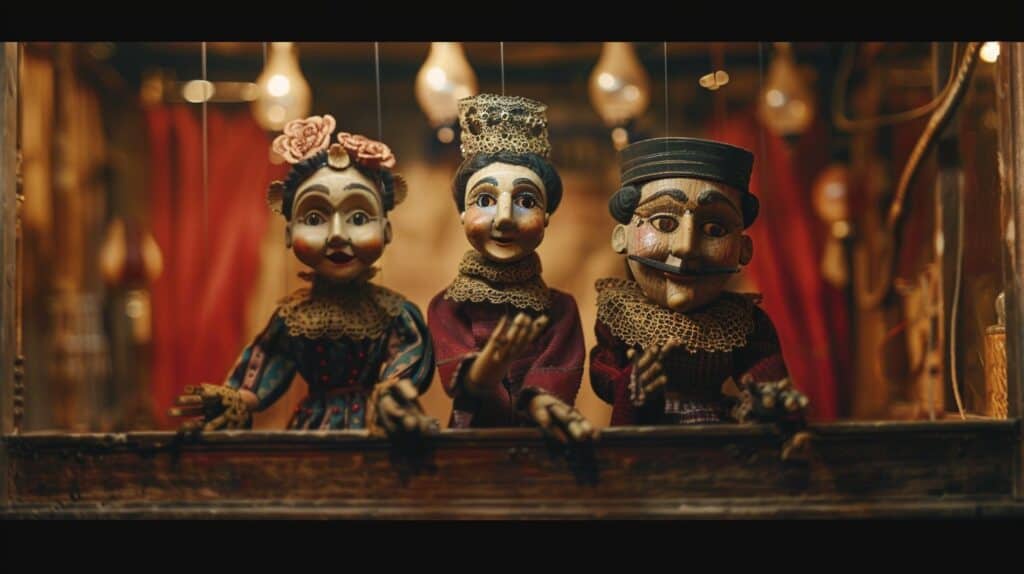
Puppetry is like bringing stories to life without needing a screen or a book. It’s where your hands and imagination team up to create magic, laughter, and sometimes even teach a lesson or two.
The Fundamentals of Puppetry
Diving into puppetry isn’t just pulling strings or making dolls dance. It’s an art that blends storytelling with craftsmanship, tapping into creativity and helping you unwind after a long day.
- Choose your puppet type: Decide whether you want to work with hand puppets, marionettes (string puppets), or shadow figures. Each has its own charm and requires different skills.
- Gather materials: You don’t need a fancy workshop. Start with basic supplies like fabric, yarn for hair, buttons for eyes, and needles. For marionettes, add some lightweight wood or sturdy wire.
- Master the basics of manipulation: Learning how to make your puppet move naturally is key. Practice simple movements like waving, nodding, and walking. The goal is to bring it to life in your hands.
- Create a character: This is where the real fun begins! Develop your puppet’s backstory, personality, and voice…yes, voice! Think about what makes them special and how they fit into the stories you want to tell.
- Build a stage: You don’t need an actual stage; a corner of your room or even behind the couch works great for putting on shows. Just make sure there’s enough space for both performer and audience.
- Write a script: Start simple with short skits or adaptations of favorite tales. As you get more comfortable, you can explore original stories that showcase your puppet’s character.
- Perform and adapt: Put on shows for friends, family, or just yourself! Pay attention to which bits get laughs or gasps, and tweak your performance accordingly.
Puppetry opens up worlds of creative expression and personal growth, no matter your skill level. Plus, it’s an excellent way to kick back… and who knows? You might just find yourself hooked on this fulfilling hobby that goes beyond mere relaxation—it’s about creating connections and bringing joy through the ancient art of storytelling with a twist of humor.
Why Puppetry is a Unique Hobby
Puppetry isn’t just moving dolls around. It’s a craft that demands creativity, pulling stories from your imagination and bringing them to life with your hands. This hobby pushes you out of your comfort zone, making you both the writer and performer of your own show.
You get to create characters, devise plots, and even make the puppets yourself. This hands-on approach doesn’t just spark joy; it lights a bonfire.
Classes and workshops are available for those ready to try their hand at this expressive activity. They offer a chance not only to learn new techniques, but also to meet others who share this passion.
Whether it’s crafting the next marionette or scripting a short play for sock puppets, puppetry offers endless possibilities for personal growth and social interaction. Each creation is a reflection of its maker—unique, imaginative, bursting with life.
Next up: Spoken Word Performance.
Spoken Word Performance

Spoken Word Performance lets you paint pictures with words, turning breath into art. It’s all about hopping on stage and bringing stories to life by playing around with the rhythm of your speech.
The Basics of Spoken Word
Spoken word is poetry meant to be heard, not just read. It’s an art form that lets you paint pictures with words and share your story. Here’s how to dive into spoken word, step by step:
- Get inspired: Listen to some of the greats—think poets at open mics or video recordings online. Notice how they use their voice, pauses, and gestures to add depth.
- Write freely: Start jotting down your thoughts without worrying about how they sound. This is about getting those raw emotions on paper.
- Play with words: Now, shape those thoughts into something more poetic. Look for ways to make your language vivid and engaging.
- Practice out loud: This part’s crucial. Read your poem aloud as if you’re telling it to someone else. Pay attention to where you naturally want to pause or emphasize.
- Record yourself: Use your phone or any basic recording device for this task. Listening back helps you catch things you might miss while performing live.
- Edit ruthlessly: Cut out anything that doesn’t serve the poem or your message. Every word should pull its weight.
- Find a rhythm: Unlike traditional poetry with strict meters, spoken word has a more natural flow. Still, think about the tempo and rhythm of your piece.
With these steps in hand, you’re ready to bring your own stories and emotions to life through spoken word—making it a personal yet universally relatable art form.
Next up, we’ll look into 3D Modeling—another creative outlet where tech meets imagination…
Why Spoken Word is a Unique Hobby
Spoken word lets you throw your thoughts and feelings out into the open. It’s like opening a door to your mind, letting every idea have its moment in the sun. You get to play with words, bending them to share your stories or make people laugh.
And let’s be honest, making someone else crack up or think deeply is pretty awesome.
This hobby isn’t just about having fun; it’s good for you, too. Learning how to string words together improves how you communicate every day. Plus, performing helps dust off those public speaking skills that might come in handy at work or social gatherings.
And there’s more – diving into spoken word can ease stress and give your mental health a boost because it feels great to express yourself and be heard. Whether you’re a newbie starting out or someone who loves being on stage, spoken word has something for everyone.
3D Modeling
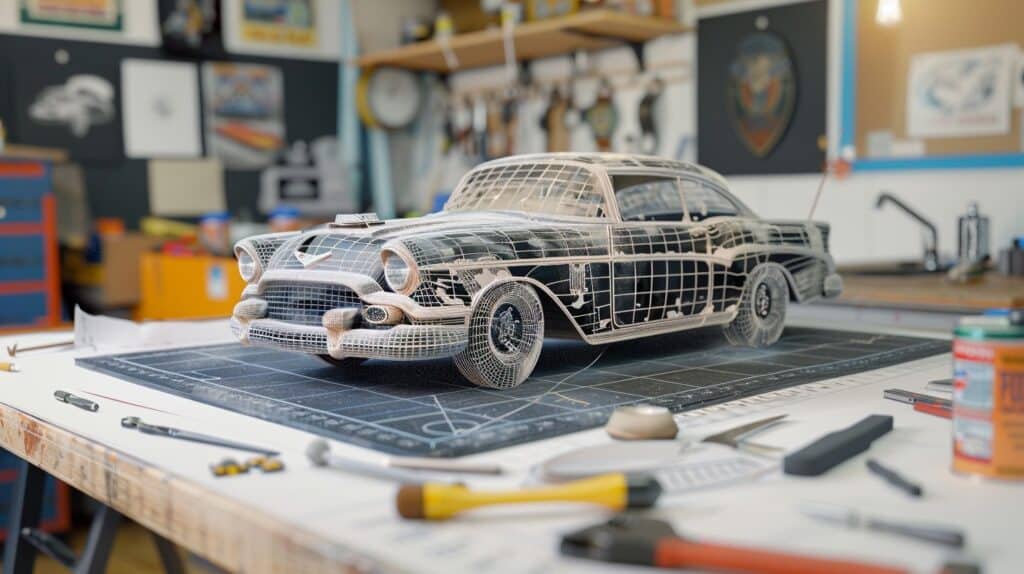
3D modeling is like crafting your digital world, piece by piece. It’s not just pushing buttons; it’s creating anything from cartoon characters to entire cities with software on your computer.
The Fundamentals of 3D Modeling
Dive into 3D modeling, and you’re unlocking a door to endless creative possibilities. It’s not just about making cool visuals; it’s a way to build skills that blend art and technology seamlessly.
- Start with the basics: Learn to use design software like Blender or SketchUp. These programs are your bread and butter, letting you create everything from simple models to intricate scenes.
- Know your tools: Familiarize yourself with terms like “mesh,” “vertices,” and “textures.” They’re the building blocks of your 3D creations.
- Practice makes perfect: Begin with simple projects. A coffee mug or a table can teach you loads about the dimensions and realism in digital art.
- Tutorials are gold: The internet is stacked with guides, from YouTube videos to forum posts by other 3D artists. Use them well.
- Light it up: Understanding lighting is crucial. It can make your model look lifelike or flat and dull.
- Keep an eye on proportions: If something looks off, it probably is. Measure twice, cut once applies here too.
- Texture wisely: Adding textures brings your model to life but remember, less can be more. Find that sweet spot where realistic meets artistic.
- Get feedback: Share your work online or with friends who have a keen eye for design. Constructive criticism will help you grow faster than you think.
- Explore different styles: Maybe hyperrealistic isn’t your thing; that’s okay! Try cartoonish designs, abstract shapes, or whatever tickles your fancy.
Each step brings its own set of challenges but also triumphs… Keep at it, and soon you’ll see how far you’ve come – one vertex at a time!
Why 3D Modeling is a Unique Hobby
3D modeling lets you create anything from cartoon characters to realistic houses using a computer. Imagine turning your wildest ideas into models that look like they’re ready to jump off the screen.
You get to play, design, and even bring stories to life. Plus, you learn cool new tech skills along the way—not just pressing buttons but making magic happen in a virtual workspace.
This hobby isn’t just about having fun, though; it’s a brain workout too. Each project challenges you, making your problem-solving skills sharper with every model you build. And let’s not forget, showing off your finished 3D masterpieces feels awesome.
It boosts your mood and gives a solid sense of achievement. Whether for leisure or maybe even making some cash on the side—3D modeling opens doors to endless possibilities and adventures in creativity.
Ventriloquism

Ventriloquism lets you throw your voice like a baseball, making it seem like it’s coming from somewhere else. It’s not just about talking without moving your lips; it’s turning dummies into characters with stories of their own!
The Fundamentals of Ventriloquism
Ventriloquism is more than throwing your voice. It’s an art form that takes skill, practice, and a bit of humor. Here’s how to get started:
- Learn the basics of voice modulation. Your voice needs to bend and twist in new ways.
- Pick the right dummy or puppet for your act. This partner will be your second half on stage.
- Get comfortable with lip control. Keeping your lips still is key while making your puppet “speak.”
- Practice speaking without moving your lips. Use a mirror and watch for any movement.
- Work on throwing your voice to make it seem like it’s coming from somewhere else.
- Develop different voices for different characters. Each character should have its own unique sound.
- Write scripts for your acts – comedy usually hits the spot!
- Engage with your audience as both yourself and through your puppet.
- Record yourself to catch mistakes and improve.
- Join online communities or groups dedicated to ventriloquism to learn from others.
Remember, mastering ventriloquism takes time and patience, but it’s also loads of fun and a great way to entertain friends, family, or even turn it into a creative career path with teaching programs and performances!
Why Ventriloquism is a Unique Hobby
Talking without moving your lips sounds impossible, right? Well, that’s the magic of ventriloquism. It’s not just throwing your voice into a dummy or puppet; it’s about bringing a character to life.
This hobby stretches the mind and demands creativity, making it stand out from other pastimes. You get to write scripts, crack jokes, and tell stories—all through another “person.” Imagine performing at parties or online for friends—it’s a guaranteed icebreaker.
Learning ventriloquism also sharpens the brain. Juggling dialogue between you and your puppet improves memory and attention to detail. Plus, mastering this art fosters self-expression in a fun way—perfect for creative minds looking for an outlet.
And with stress relief as one of its benefits, it’s like hitting two birds with one stone: unwind while practicing something cool. Online communities offer loads of support too; guidance is just a click away if you ever hit a snag or seek inspiration from fellow ventriloquists’ performances posted on social platforms like YouTube or Twitch—making this hobby both accessible and sociable.
Seed Art Creation
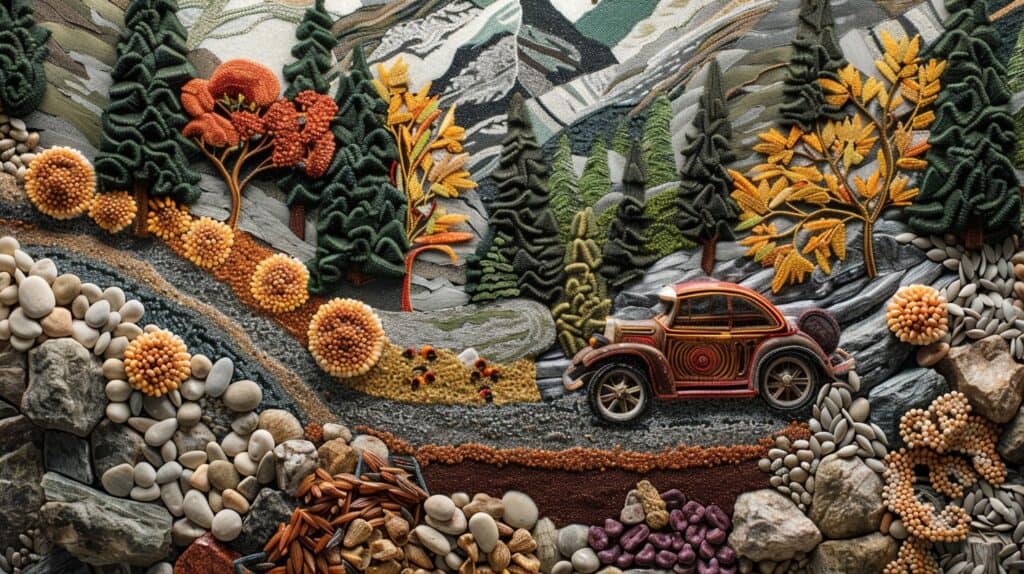
Seed Art Creation turns tiny seeds into stunning pictures or sculptures – think of it as painting, but with seeds instead of brush strokes. This hobby isn’t just about sticking seeds on a board; it’s an exercise in creativity and patience, where each seed adds to a larger masterpiece.
The Basics of Seed Art Creation
If you think playing with seeds is just for birds, think again. Seed art creation is where creativity meets nature, and let me tell you, it’s a game-changer for your free time. Here’s how to get started:
- Gather your materials – You’ll need seeds, of course. Think sunflower, pumpkin, and sesame for starters. Don’t forget glue, a backing material like cardboard or wood, and some clear varnish.
- Pick your design – Start simple. A flower or a tree is good. Or dive into something personal, like your initials or favorite animal.
- Lay out your design – Sketch it on the backing material first. This step helps keep everything neat.
- Glue time – Apply a thin layer of glue on one small section at a time. Then press the seeds onto the glue according to your design.
- Color play – Mix different seed types to add color and texture to your artwork.
- Seal the deal – Once the glue dries, brush on some clear varnish to protect your masterpiece.
- Show off – Find a spot in your home or office where your seed art can shine.
- Blog about it – Share your progress updates and creative projects online. Who knows? You might inspire others or even start profitable blogging about seed art creation techniques and style recommendations.
- Keep experimenting – Try mixing seeds with other materials like beads or pieces of fabric for more intricate designs.
Remember, patience is key here… Good things grow with time – and that includes your skills in seed art creation! So go ahead, give it a whirl; let those tiny seeds bring big joy into your world of hobbies.
Why Seed Art Creation is a Unique Hobby
Now that we’ve covered how seed art begins, let’s delve into what sets it apart as a hobby. Crafting with seeds isn’t just another way to pass the time. It’s an exploration of creativity and nature combined.
Every piece you create tells a story—your story—through the colors, shapes, and types of seeds you select. Imagine turning sunflower and pumpkin seeds into a stunning mural, or tiny mustard seeds into intricate patterns on handmade cards.
Seed art boosts your mood, sharpens your focus, and can even turn into a side gig if you’re up for it. You’ll find yourself losing track of time as you arrange each seed by hand—it’s that absorbing.
Plus, sharing tips, tutorials, or gear reviews online can connect you with a community of like-minded creators. And who knows? Your next project could be the talking point at family gatherings or earn praise from friends on social media.
With every creation, you not only improve your craft but also enhance your mental well-being—a win-win in any book.
Bone Carving
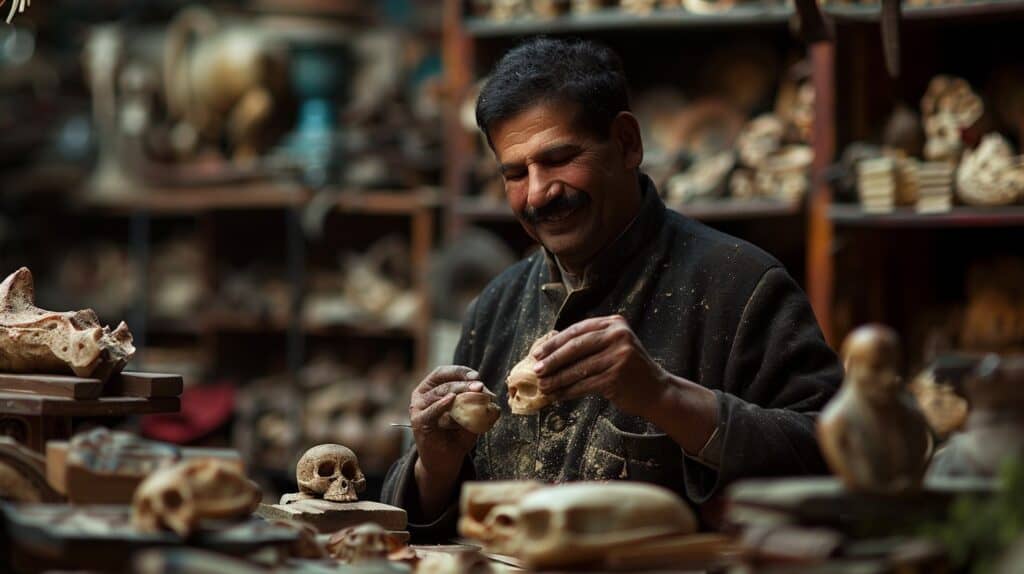
Bone carving takes patience and a steady hand. It turns simple bones into incredible works of art.
The Fundamentals of Bone Carving
Bone carving hooks you right in, combining art with a touch of ancient craftsmanship. It’s where creativity meets tradition, letting you create exceptional pieces from the comfort of your home. Here’s how to get started on your bone carving adventure:
- Choose Your Tools Carefully – Start with basic sculpting instruments. A sturdy knife, fine-grit sandpaper, and a small saw are essential. Think of them as your paintbrushes in this art form.
- Select the Right Bone – Not all bones are created equal. Look for dense ones like cow or deer for your projects. They’re easier to handle and carve into intricate designs.
- Clean the Bone Thoroughly – Before carving, ensure the bone is spotless and free from any meat or marrow. Boiling it in soapy water does the trick, followed by sun-drying to remove moisture.
- Sketch Your Design First – Use a pencil to outline your design directly on the bone. It’s like drawing on canvas before painting; it guides your carving path.
- Safety Gear Is a Must – Don’t forget to wear protective eyewear and gloves. Bone dust isn’t something you want in your eyes or lungs.
- Start Carving Slowly – Take your time with each cut and carve away from yourself to avoid accidents. Patience is key in getting those fine details just right.
- Smoothing Out Your Creation – Once carved, use sandpaper to smooth out rough edges and give your piece a polished look.
- Finishing Touches Are Crucial – Apply mineral oil or beeswax to finish off your piece, which will help preserve the bone and bring out its natural shine.
- Practice Makes Perfect – Like with any craft, the more you practice bone carving, the better you’ll become at turning simple bones into masterpieces.
- .Share Your Work Online – Join online communities of fellow carvers where you can show off your creations and pick up new techniques along the way.
Embarking on this journey not only sharpens your artistic skills but connects you deeply with history and tradition—turning mere bones into objects of beauty that tell their own stories.
Why Bone Carving is a Unique Hobby
Bone carving taps into your creative side in a way that few hobbies can. Picture yourself turning a piece of bone, something so simple and raw, into art. It’s like magic, but real.
This hobby lets you get hands-on with materials and tools, carving out beautiful pieces that hold stories within them. It’s not just about the end result; it’s the journey there that fills you with pride.
This craft offers more than just a way to pass time—it’s meditative and soothing for your mind. Imagine sitting down after a long day and losing yourself in the intricate details of your workpiece.
The world fades away as your hands move, shaping something remarkable from nothingness. Bone carving strengthens personal growth and mental well-being by requiring focus and patience, making it stand apart from other pastimes.
Plus, showing off a finished piece brings immense satisfaction knowing you’ve created something one-of-a-kind—talk about an epic conversation starter!
Beekeeping
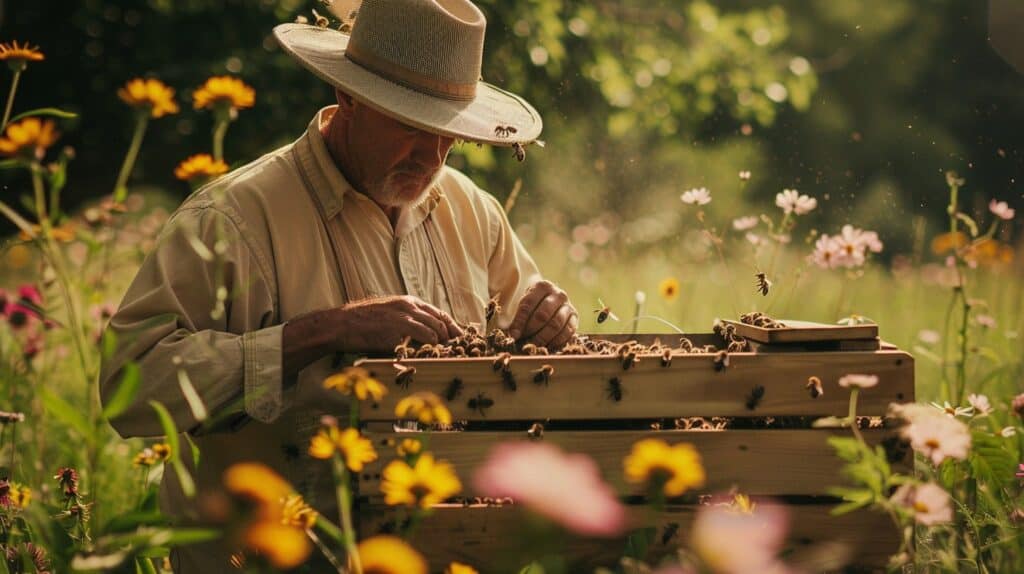
Beekeeping lets you dive into the buzz of nurturing your own honeybee families. It’s a sweet journey—literally—that connects you with nature and gives back golden treasures.
The Basics of Beekeeping
Beekeeping is not just about buzzing bees and sweet honey. It’s a hobby that can boost your creativity, help the environment, and even turn into a source of income. Let’s break it down to the basics, shall we?
- Get to know your tiny workers – Learn about different kinds of bees in a colony. You have the queen, workers, and drones. Each has its own job.
- Find a cozy spot for them – Choose a sunny place in your yard where flowers bloom aplenty. Bees love the sun and need flowers for nectar.
- Suit up for safety – Wear protective clothing like gloves and a veil. You don’t want any surprise stings during your bee encounters.
- Pick out their home – Get a beehive from a local supplier or online store. There are many types, but start with something simple.
- Welcome them properly – Buy or find a swarm of bees to introduce to their new home. Be gentle and calm; they’re more scared of you than you are of them.
- Feed them well – Sometimes bees need extra food, especially when starting out or during winter. Sugar syrup can do the trick.
- . Check on them regularly – Inspect your hive every two weeks or so. Look out for diseases and make sure there’s enough space for honey storage.
- . Harvest at the right time – Wait until late summer or early fall to collect honey. Leave enough for the bees; they worked hard for it!
- . Keep learning – Beekeeping is an evolving field with lots to learn about behaviors, wellness practices for colonies, and ways to better support the ecosystem.
- . Enjoy the fruits… I mean honey – After all that work, savor the sweet taste of your very own honey! Plus, think about all those happy flowers around thanks to your bees’ pollination efforts.
Remember: patience is key in beekeeping! Sometimes things go smoothly; other times you might face challenges like pests or bad weather… But hey, overcoming these hurdles makes you not just a beekeeper but also part gardener, scientist, and craftsman all rolled into one!
Why Beekeeping is a Unique Hobby
Getting into beekeeping is like unlocking a secret garden where relaxation and creativity bloom. You get your hands dirty, literally, with beeswax and honey, while the buzz around you melts away stress like nothing else.
It’s not just about producing sweet treats; it’s about growing as a person too. This hobby boosts your mood and sharpens your brain in ways that sitting indoors never could.
Beekeeping ties you to nature’s rhythms unlike any other pastime. You learn to read the weather, understand the biology of bees, and contribute to biodiversity by keeping these crucial pollinators thriving.
Plus, there’s something deeply satisfying about harvesting your own honey—it tastes of accomplishment and sunshine. And hey, who doesn’t want a bit more sweetness in their life? Now let’s talk gardening, but on another level—terrarium building awaits!
Candle Making
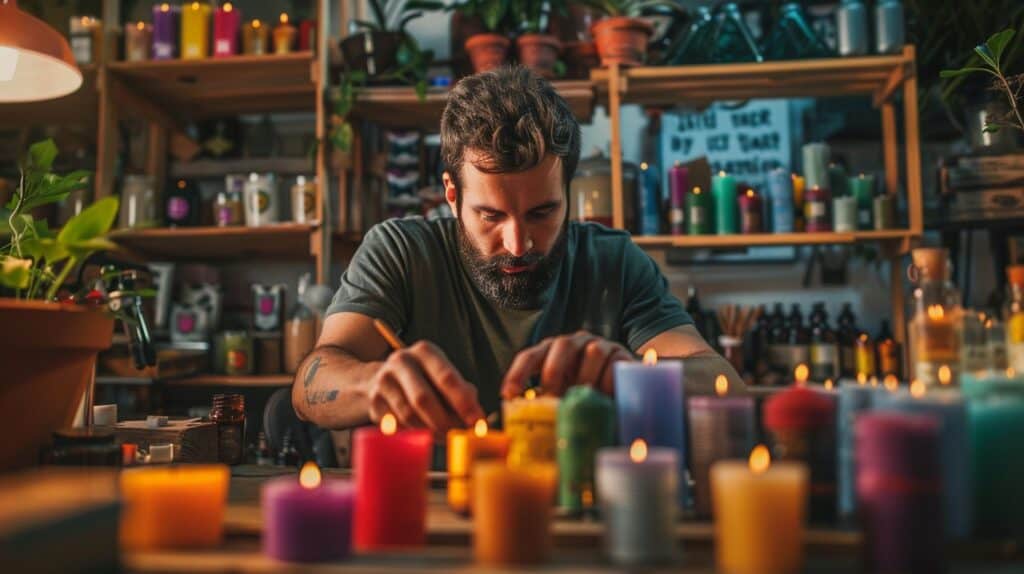
Dipping wicks, melting wax, adding a splash of fragrance. Candle making lets you craft your own light. It’s like mixing a potion where the magic ingredient is your creativity.
The Basics of Candle Making
Candle making is like brewing your own beer but for the nose. It’s creative, and you can share the scents you love with friends and family. Here’s how to get started:
- Gather supplies. You’ll need wax—soy or beeswax works great—wick, a pitcher for melting, and scent oils if you want your candles to have a fragrance.
- Choose your containers. Old mugs, tea cups, or any heat-resistant container can add character to your candles.
- Melt the wax in your pitcher using a double boiler setup. A pot filled with water on the stove does the trick—just keep that flame low.
- Add color or scent oils once the wax is liquid. This part’s like adding spices to a stew until it smells just right.
- Attach the wick to the bottom of your container. A dab of hot wax can hold it in place.
- Carefully pour the melted wax into your container. Slow and steady wins this race.
- Let it cool down and solidify. Patience is key here; think of it as letting wine age.
- Trim the wick to about half an inch above the wax for a perfect burn.
And there you go! You’ve just made your first candle—the start of many, hopefully.
Next up, let’s dip our toes into another creative venture: tarot card reading…
Why Candle Making is a Unique Hobby
You might think candle crafting is just melting wax and pouring it into holders. But, oh boy, are you in for a treat. This hobby dives deep into relaxation and lets your creativity run wild.
Imagine designing your own illuminators that not only light up the room but also reflect your personality. You get to play with scents, colors, and shapes—it’s like being a kid again but with better tools!
It’s more than just an activity; it’s a journey of personal growth and skill-building. Every time you create a new luminary, you learn something new about artistry and even science.
The sense of accomplishment when striking a match to light your handmade piece? Unmatched. Plus, it’s the perfect way to unwind after a long day or week—crafting something beautiful by hand while possibly enjoying some craft cocktails or listening to orchestral scores that you love.
Who knew hobbies could be so multifaceted?
Tarot Card Reading

Tarot card reading is like opening a mysterious book about your own life. It’s not just picking cards—the symbols and pictures tell stories, guiding you through your questions and wonders.
The Fundamentals of Tarot Card Reading
Getting into tarot card reading opens up a whole new path for personal growth and creativity. It’s like cracking open a book where every page tells a piece of your story, but with pictures.
- First things first, grab yourself a deck. But not just any cards – find ones that speak to you. The images should jump off the page, making you feel something deep inside.
- Next up, get cozy with the card meanings. Each one has its own vibes and tales. Think of it as learning a new language, but instead of words, you’ve got symbols and signs.
- Practice makes perfect, they say. Start by pulling a card each day to see what’s in store or what you should focus on. It’s like getting daily advice from an old, wise friend.
- Now, let’s talk spreads – nope, not the kind you put on bread. In tarot lingo, it’s about how you lay out the cards to dive deep into situations. Each layout offers different insights and answers.
- Connect the dots between your life and the cards. This bit is key! It’s not just about knowing what each card means, but also how it fits into your world or the question at hand.
- Keep notes in a journal or maybe start bullet journaling about your readings — what cards came up, how you felt, and what unfolded since then? This way, you’re not just guessing; you’re learning from experience.
- Share your journey with others but don’t fixate on becoming an expert overnight; everyone has their own pace when exploring tarot reading.
By diving into this crafty hobby with curiosity and an open mind, men can unlock avenues for creativity while embarking on a ride toward self-discovery and improved mental well-being – all thanks to those artful little cards that hold more power than meets the eye.
Why Tarot Card Reading is a Unique Hobby
Tarot card reading takes you on a mystical journey. It’s like opening a book that tells more about your life, emotions, and potential future than any novel could. Imagine sitting down with a deck of cards, each picture ready to spark ideas or shed light on a situation.
You don’t have to be an expert from the get-go; there’s room for everyone to grow in understanding and skill.
This hobby isn’t just pulling cards out of a pack; it’s about connecting dots between symbols, colors, and intuition. Think of it as combining art, storytelling, and counseling but without needing an appointment or couch.
Plus, sharing readings can create conversations deeper than usual chit-chat over coffee or during game night. It opens doors to exploring creativity while also offering insights into personal wellbeing – all wrapped up in the shuffle of a deck.
FAQs about Niche Hobbies
Is puppetry only for kids’ shows?
No way! Puppetry is an ancient form of storytelling that can bring characters to life in ways that amaze both young and old. It’s like being a director of your own performing arts show, but your actors are puppets!
Can beekeeping really buzz up my life?
Absolutely! Beekeeping is not just about getting sticky with honey. It’s a dive into the buzzing world of honeybee colonies, teaching patience and care. Plus, you get to make your own sweet treats and maybe even some home-brewed beverages.
How do hobbies like crocheting or knitting help me chill out?
These aren’t just for grandmas anymore! Knitting or crocheting lets you create something from just a ball of yarn and hooks or needles – talk about magic fingers! Plus, it’s super relaxing and can help keep those stress monsters at bay.
Are there hobbies out there for adventure seekers?
You betcha! From falconry where you get to be best buds with birds of prey, to cycling down trails faster than a speeding bullet, outdoor recreational activities are endless. Get ready to have stories that sound straight out of an adventure book.
Do creative hobbies offer any real benefits besides killing time?
For sure! Getting crafty with things like sewing quilts or doing graphic design on the computer isn’t just fun; it exercises your brain in new ways which can improve cognitive function over time – say goodbye to boredom blues!
Can niche hobbies connect me with others?
Yes, indeed! Whether it’s swapping tips online about the best soil for permaculture design or joining a local group for wine tastings, these unique interests open doors to meet folks who get as excited as you do about what might seem like quirky passions to others.




